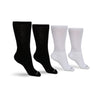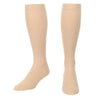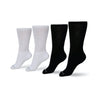Are Diabetic Socks The Same As Compression Socks?

Table Of Contents:
Diabetes affects millions of people worldwide and is a leading cause of foot problems. Wearing appropriate socks can help prevent and manage foot problems in people with diabetes. However, there is often confusion about whether diabetic socks and compression socks are the same thing. This article will explore the differences and similarities between diabetic socks and compression socks.
What are Diabetic Socks?
Diabetic socks are specially designed to provide extra cushioning and protection for sensitive feet, reducing the risk of blisters, sores, and other foot problems. According to the American Diabetes Association, people with diabetes are at a higher risk of developing foot problems, including neuropathy and poor circulation. Diabetic socks are made from soft, breathable materials and have a non-binding top to prevent irritation and pressure points.
Diabetic socks also have seamless construction to reduce the risk of rubbing and blisters. They are designed to fit snugly but not be too tight, to prevent restriction of blood flow to the feet. Diabetic socks can help prevent foot ulcers and other complications associated with diabetic feet.
What are Compression Socks?
Compression socks are designed to improve blood flow and reduce swelling in the legs and feet. They apply pressure to the legs and feet, helping to improve circulation and prevent blood from pooling in the lower extremities. Compression socks are often recommended for people who sit or stand for long periods, such as during air travel or work.
Compression socks are made from a variety of materials, including nylon and spandex. They come in different levels of compression, ranging from mild to firm. Compression socks can help prevent blood clots, varicose veins, and other circulatory problems.
Differences Between Diabetic Socks and Compression Socks
While diabetic socks and compression socks share some similarities, they are not the same thing. Here are some key differences between the two:
- Materials used: Diabetic socks are made from soft, breathable materials such as bamboo or cotton, while compression socks are often made from synthetic materials like nylon or spandex.
- Design and construction: Diabetic socks have seamless construction to reduce the risk of rubbing and blisters, while compression socks often have ribbed or textured designs to provide additional support and compression.
- Purpose and intended use: Diabetic socks are designed to protect sensitive feet and prevent foot ulcers, while compression socks are designed to improve blood flow and reduce swelling in the legs and feet.
- Who can benefit: Diabetic socks are designed specifically for people with diabetes, while compression socks can benefit anyone who sits or stands for long periods or has circulatory problems.
Similarities Between Diabetic Socks and Compression Socks
Despite their differences, there are some similarities between diabetic socks and compression socks:
- Overlapping benefits: Both diabetic socks and compression socks can improve foot health and reduce the risk of foot problems, including blisters, sores, and swelling.
- Variety of styles and materials: Both types of socks come in a variety of styles and materials, so people can choose the option that best meets their individual needs.
- Available in different compression levels: Diabetic socks can be designed with mild compression, while compression socks are available in different levels of compression.
According to a study published in the Journal of Diabetes Science and Technology, wearing diabetic socks can significantly reduce the risk of foot ulcers in people with diabetes. The study found that patients who wore diabetic socks had a lower incidence of foot ulcers and required fewer medical interventions than those who did not wear diabetic socks.
In a survey of people with diabetes who wore diabetic socks, 87% reported that the socks were comfortable, and 86% said that they reduced foot pain. Many people also reported that diabetic socks helped to prevent blisters and sores on their feet, and improved overall foot health.
Similarly, compression socks have been shown to have a positive impact on foot health. A study published in the Journal of Vascular Surgery found that compression stockings can reduce the incidence of leg swelling and blood clots in patients undergoing surgery.
Testimonials from people who wear diabetic socks and compression socks also highlight their benefits. Many people report that diabetic socks have improved their foot health and reduced the risk of foot problems. For example, one person said, "I've been wearing diabetic socks for a few years now, and I've noticed a significant improvement in my foot health. I used to get blisters and sores all the time, but now I rarely have any problems."
Similarly, people who wear compression socks report that they help to reduce leg swelling and improve circulation. One person said, "I work in an office and sit at a desk all day, and my legs used to get really swollen and achy. Since I started wearing compression socks, I've noticed a big difference. My legs feel much better, and I don't have as much swelling."
Conclusion
Diabetic socks and compression socks are not the same thing, but they can both have a positive impact on foot health. Diabetic socks are designed to protect sensitive feet and reduce the risk of foot ulcers, while compression socks improve blood flow and reduce swelling. Both types of socks come in a variety of styles and materials, and can be designed with different levels of compression. Studies and testimonials demonstrate the benefits of both diabetic socks and compression socks in improving foot health and reducing foot problems. If you have diabetes or circulatory issues, talk to your healthcare provider about whether diabetic socks or compression socks may be right for you.
1 comment
Best Sellers
-
Men's Cotton Diabetic Crew Socks (6 Pair)
![]()
- Regular price
- $39.99
- Sale price
- $39.99
- Regular price
-
$79.95 - Unit price
- per
Sold out





-
Men's Cotton Diabetic Ankle Socks (6 Pair)
![]()
- Regular price
- $39.99
- Sale price
- $39.99
- Regular price
-
$69.95 - Unit price
- per
Sold out


-
Men's Ultra-Soft Upper Calf Diabetic Socks (4 Pair)
![]()
- Regular price
- from $39.99
- Sale price
- from $39.99
- Regular price
-
$79.95 - Unit price
- per
Sold out


-
Women's Cotton Diabetic Crew Socks (6 Pair)
![]()
- Regular price
- $39.99
- Sale price
- $39.99
- Regular price
-
$79.95 - Unit price
- per
Sold out




-
Women's Cotton Diabetic Ankle Socks (6 Pair)
![]()
- Regular price
- $39.99
- Sale price
- $39.99
- Regular price
-
$79.95 - Unit price
- per
Sold out


-
Men's Over The Calf Compression Stocking Socks (1 Pair)
![]()
- Regular price
- from $19.99
- Sale price
- from $19.99
- Regular price
-
$31.95 - Unit price
- per
Sold out





-
Women's Ultra-Soft Upper Calf Diabetic Socks (4 Pair)
![]()
- Regular price
- from $39.99
- Sale price
- from $39.99
- Regular price
-
$79.95 - Unit price
- per
Sold out


-
DSC Hemp Cream For Neuropathy Aches & Nerve Pain (Peppermint)
![]()
- Regular price
- from $39.99
- Sale price
- from $39.99
- Regular price
-
$59.95 - Unit price
- per
Sold out










I’m a former athlete and normal cocks create a large indentation around me legs. Doctors see this but none recommend treatment. I’ve spend 100s of dollars buying socks that will not help my condition. What kind of doctor should I consult. Can they help me write a prescription for the right socks?